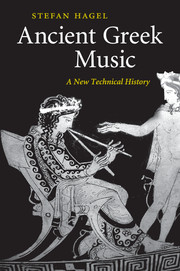Book contents
- Frontmatter
- Contents
- List of diagrams
- List of tables
- List of figures
- List of abbreviations
- Preface
- 1 The evolution of ancient Greek musical notation
- 2 Notation, instruments and the voice
- 3 Notation in the handbooks
- 4 Strings and notes
- 5 Fine tuning
- 6 Going beyond Ptolemy?
- 7 Assisted resonance
- 8 The extant musical documents
- 9 Aulos types and pitches
- 10 Before Aristoxenus
- 11 Synthesis
- Bibliography
- Indices
3 - Notation in the handbooks
Published online by Cambridge University Press: 03 May 2010
- Frontmatter
- Contents
- List of diagrams
- List of tables
- List of figures
- List of abbreviations
- Preface
- 1 The evolution of ancient Greek musical notation
- 2 Notation, instruments and the voice
- 3 Notation in the handbooks
- 4 Strings and notes
- 5 Fine tuning
- 6 Going beyond Ptolemy?
- 7 Assisted resonance
- 8 The extant musical documents
- 9 Aulos types and pitches
- 10 Before Aristoxenus
- 11 Synthesis
- Bibliography
- Indices
Summary
GAUDENTIUS, ALYPIUS, BACCHIUS, BELLERMANN'S ANONYMI
Once the historical and structural primacy of the Lydian key is established, the usage of notation as found in most of the later treatises fits into the picture quite readily: here, too, the Lydian regularly maintains its primary status.
Firstly, we encounter a sort of fixed order in which the tónoi of the notation were presented. Since this approach is based on the triads, it cannot be older than the latest version of the notation with its fifteen keys. It comprises three complete series of tónoi, one for each genus: first the diatonic, then the chromatic, and finally the enharmonic. The triads are enumerated in descending pitch, and within each triad, the basic scale is followed by its ‘Hypo–’ and ‘Hyper–’ variants. As a result, the Lydian triad comes first, the Dorian last, and the tables start from the plain Lydian tónos. These lists constitute the body of Alypius' book (or what we have of it). They were apparently appended to Gaudentius' treatise as well, although only the part from diatonic Hypolydian to Hypoaeolian survives in the manuscript tradition. The lists were truncated quite early, and on top of this the Lydian key has been lost, together with part of the preceding chapter(s). Still the arrangement is the same as in Alypius, and the sequence of Hypolydian – Hyperlydian – Aeolian – Hypoaeolian… makes sense only if the preceding lacuna is supposed to have contained the Lydian key.
- Type
- Chapter
- Information
- Ancient Greek MusicA New Technical History, pp. 97 - 102Publisher: Cambridge University PressPrint publication year: 2009



